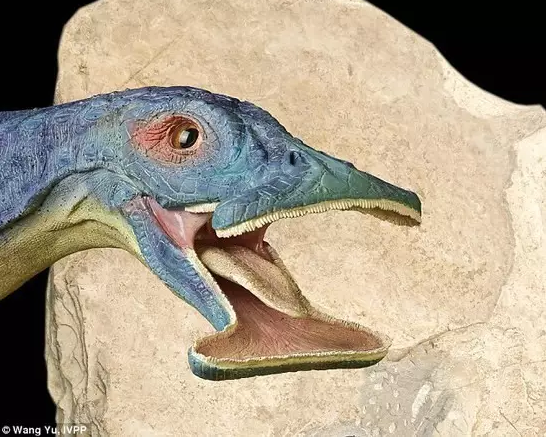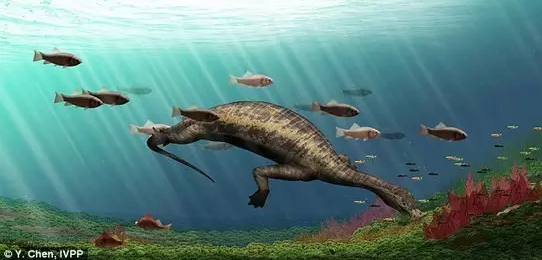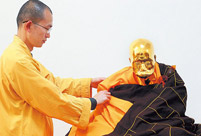


Chinese scientists have restored the image of a sea creature that was discovered in southwestern China in 2014.
The Institute of Vertebrate Paleontology and Paleoanthropology (IVPP), together with the Chinese Academy of Sciences (CAS), recently published a paper online about the fossil of the "awl head sea monster" discovered two years ago.
The strange marine reptile fossil is quite unique. It appears to have lived in the mid-Triassic period 240 million years ago, and it possesses a very abnormal skull structure. Studies show that its maxilla grows vertically and it possesses fence-like teeth. It belongs to the filter-feeding marine reptile group. For now it has been named "singular filter-toothed dragon.”
However, since the fossil is not in very good shape, the research team has continued to look for other fossils from the same species in order to compare. After a long period of searching and then repair, two skulls almost without any deformations were uncovered from the surrounding rock. According to team leader Li Chun, the snouts of the two new specimens were not vertical, but horizontal and wide. They featured three types of teeth, including varieties for both grazing and filtering algae. The news specimens offer the earliest record of herbivorous marine reptiles.

“The structure shocked us. The exaggerated changes of the snout have been found in some prehistoric amphibians and modern hammerhead sharks, though the situation is not exactly the same. We observed this rare phenomenon for the first time in reptiles, and we call it 'hammer head,’” Li explained.
The discovery of the strange filter-toothed reptile proves that the adaptive radiation of Early Mesozoic marine reptiles is far beyond what had previously been thought. "People often think the origin of marine reptiles was in the early Triassic, but more and more new discoveries make it seem like it might be the Permian,” Li said.
 Beijing Style: ready for bare legs
Beijing Style: ready for bare legs Century-old station sees railyway evolution
Century-old station sees railyway evolution Amazing scenery of Xisha Islands
Amazing scenery of Xisha Islands Enthusiasts perform Kung Fu at Wudang Mountain
Enthusiasts perform Kung Fu at Wudang Mountain Stunning photos of China's fighter jets in drill
Stunning photos of China's fighter jets in drill Monk's mummified body to be made into a gold Buddha statue
Monk's mummified body to be made into a gold Buddha statue Asia's longest and highest suspension bridge to open to traffic
Asia's longest and highest suspension bridge to open to traffic China's first interactive robot looks like a beauty
China's first interactive robot looks like a beauty Vietnamese Su-30 fighters fly over Nanwei Island in South China Sea
Vietnamese Su-30 fighters fly over Nanwei Island in South China Sea Top 20 hottest women in the world in 2014
Top 20 hottest women in the world in 2014 Top 10 hardest languages to learn
Top 10 hardest languages to learn 10 Chinese female stars with most beautiful faces
10 Chinese female stars with most beautiful faces China’s Top 10 Unique Bridges, Highways and Roads
China’s Top 10 Unique Bridges, Highways and Roads Is Pyongyang’s no-first-use pledge new stance?
Is Pyongyang’s no-first-use pledge new stance?  Kilns stick to ancient way of making bricks despite rock-bottom demand
Kilns stick to ancient way of making bricks despite rock-bottom demand China scores back-to-back exports growth
China scores back-to-back exports growth Chinese women in intercultural marriages discuss the ups and downs of dealing with their husbands’ moms
Chinese women in intercultural marriages discuss the ups and downs of dealing with their husbands’ momsDay|Week